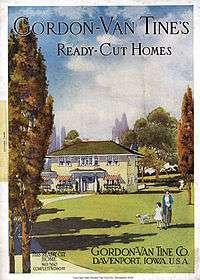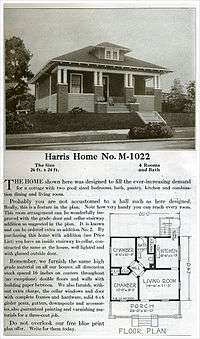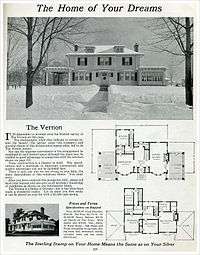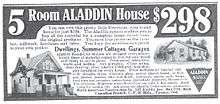Kit houses in North America





Kit houses, also known as mill-cut houses, pre-cut houses, ready-cut houses, mail order homes, or catalog homes, were a type of housing that was popular in the United States and Canada in the first half of the 20th century.[1] Kit house manufacturers sold houses in many different plans and styles, from simple bungalows to imposing Colonials, and supplied at a fixed price all materials needed for construction of a particular house, but typically excluding brick, concrete, or masonry (such as would be needed for laying a foundation, which the customer would have to arrange to have done locally).
Design
Stick-built, balloon-framed kit houses were built as permanent, not temporary structures, as the manager of the Sears, Roebuck lumber department explained to a United States Senate committee in 1919:[2]
A ready-cut house should not be confused with a sectional-portable house, which can be taken down and moved by being unbolted. A ready-cut house is a permanent house and the method of its construction is not different from any other frame house where the lumber is framed (or cut to its proper length, notched, etc.), by hand by carpenters.
Unlike modular homes, which are built in sections at a factory, in a kit house every separate piece of lumber was shipped already numbered and cut to fit its particular place in the house, thus eliminating the need for measuring and cutting, and likewise the waste of time (especially in the days before power tools) and of materials. Thus, kit home manufacturers claimed to save the customer as much as 30 to 40 percent over traditional building methods.[3][4] This description by researcher Dale Wolicki of kit house manufacture by the Gordon-Van Tine Company was typical of other kit house companies' efforts as well:[4]
All designs were standardized to maximize efficiency and reduce waste in materials and labor. Lumber and hardware were purchased in bulk. The factories had skilled employees and special machines to cut difficult pieces such as rafters and staircases. Lumber was pre-cut to length, guaranteed to fit, ready to nail, and labeled for easy assembly. Floor joists and bridging, sub-flooring, finished flooring, studs, rafters, sheathing, clapboards, shingles, stucco, plaster or drywall, columns, railings, doors and windows, hardware, nails, and paint for two exterior coats were included in the order. Plumbing, electrical, and heating systems were available for an additional charge. Although the lumber and hardware were standardized, the designs were not and buyers were encouraged to personalize their order. Many models had two or three floor plans, while the exterior could be clapboards, shingles, stucco, or framed for brick. Walls, windows, and doors could be moved, added or eliminated. Porches, sun rooms, flower boxes, trellises, balconies, built-in cabinets, and a variety of door and sash patterns were available at an additional charge.
Delivery and construction
Depending on the size and style of the plan, the materials needed to construct a typical house, including perhaps 10,000-30,000 pieces of lumber,[3] would fill one or two railroad boxcars,[5][6] which would be loaded at the company's factory and sent to the customer's home town, where they would be parked on a siding or in a freight yard for unloading. Once the materials arrived, a customer would arrange for a local carpenter or contractor to assemble the house on a piece of land owned by the customer; or a customer who was handy with tools might assemble all or part of the house himself in several weeks or a few months' time.
The resulting houses were indistinguishable in quality and appearance from those built by traditional methods, if not better, yet were often significantly cheaper to build because of the savings on carpenters' and contractors' wages; and the cost of high-quality lumber bought from a large kit house company often was lower than at the local lumber yard. In addition, some companies, including Sears, Montgomery Ward, Gordon-Van Tine, and Harris Brothers, offered cash discounts and generous mortgage terms.[4] For most homeowners, the complete cost of building a kit house was about double the catalog price, allowing for the construction of a foundation and labor costs.[3][7] The price of land or a city lot on which to build would be another expense.
Customization
In addition to their pre-cut houses, some companies also sold only the house plans (with the homebuyer purchasing all the materials locally) or non-pre-cut versions of their houses (at a lower price), leaving it up to the buyer to arrange for construction and carpentry work. According to the Sears Archives, "Sears actually encouraged builders of Modern Homes to save money by ordering their lumber from local lumber mills. Sears wanted Modern Homes to be cost-effective for buyers, which often meant purchasing materials locally and not from the few and geographically distant Sears lumber mills."[8]
Furthermore, some companies would provide reversed versions of their homes or make other modifications upon request. For example,[9]
Sears was ... a very able follower of popular home designs but with the added advantage of modifying houses and hardware according to buyer tastes. Individuals could even design their own homes and submit the blueprints to Sears, which would then ship off the appropriate precut and fitted materials, putting the home owner in full creative control.
In addition, with some companies, homebuyers could choose the quality of materials. Gordon-Van Tine offered discounts for customers who chose lesser-quality siding, roofing, doors, windows, and trim. Sears offered "Honor Bilt" homes, with the finest quality materials, as well as "Standard Built" homes that were "best for warmer climates, meaning they did not retain heat very well,"[9] and "Simplex Sectionals," made from prefabricated panels that could be bolted together, intended for use as temporary structures or summer homes.[10]
Advertising


Kit houses were promoted through catalogs available at lumber yards and hardware stores, through the mail-order catalogs published by large retailers like Sears and Wards, and through advertisements in popular magazines and newspapers in those cities where kit home manufacturers had local sales offices. Dale Wolicki lists Saturday Evening Post, National Geographic, and Good Housekeeping as examples of magazines where Gordon-VanTine advertised.[4] Prospective customers could arrange to inspect kit houses in their vicinity or visit a company's factory to tour model homes.[4][11]
The ease of construction and cost savings of kit houses appealed to many would-be homeowners across the economic spectrum, from blue-collar workers to the affluent. For example, in 1928 Walt Disney and his brother Roy built two kit houses made by Pacific Ready Cut Homes on lots they owned in the Silver Lake neighborhood of Los Angeles.[11]
The popularity of kit houses was attested in a roundabout way in the 1920 silent comedy One Week starring Buster Keaton, which shows Keaton constructing a build-it-yourself house that turns out all wrong.[12]
Kit house companies
A number of companies offered kit houses, and sometimes also offered rudimentary "industrial" and summer cottages lacking bathrooms,[13] as well as garages, duplexes, apartment buildings, barns and other farm buildings, and even outhouses.[9]
Canada
The largest sellers in Canada were:
- Canadian Aladdin Co. Ltd. – a branch plant, of the Michigan-based Aladdin Homes, the largest kit home seller in Canada, its Canadian headquarters were located in the Canadian Pacific Building, in Toronto. They operated across the whole of Canada, from 1905 to 1952. They were truly pre-cut, and need very little skill to assemble. They also featured high-quality lumber, and the company offered a refund of $1 for each knot found in a kit.[14]
- The T. Eaton Co. Ltd. – by far the most important mail-order general retailer in Canada in the early twentieth century, it was also a provider of house kits from 1910 to 1932. They were only available in Western Canada, not in Ontario or the East. Eaton's sold at least 40 different house plans, but the most common type was the one-and-a-half storey, sometimes referred to as the semi-bungalow. In the 1919 and 1920 catalogues, all Eaton's houses were given a name starting in "Ea", thus, the Eatoncourt, Eastbourne, Easton, Eager, Earlswood, and Earlscourt. Although Eaton's house were sold as a kit similar to other companies, they were not pre-cut.[14]
- Other smaller providers of mail-order kits included The B.C. Mills Timber and Trading Co., United Grain Growers, the University of Saskatchewan, and the Manitoba Agricultural College.[14]
United States
Over 100,000 kit homes were built in the United States between 1908 and 1940.[5] Companies offering kit houses during all or part of their corporate existence included:[1]
- Aladdin Homes, Bay City, Michigan – 1906 to 1981[15][16][17][18]
- Bennett Homes, North Tonawanda, New York – 1902 to 1935 or later[19][20][21]
- Fenner Factory Cut Homes, Ready Built House Company, North Portland, Oregon – 1912 to 1928[22]
- Gordon-Van Tine Homes, Davenport, Iowa, with additional plants in St. Louis, Missouri,[23] Chehalis, Washington, and Hattiesburg, Mississippi – 1907 to 1947[4][21][24]
- Harris Homes, Harris Brothers Company, Chicago, Illinois – 1913 to 1960[21][25][26]
- Hewitt-Lea-Funck Company, Seattle, Washington[27]
- Liberty Homes, Lewis Manufacturing, Bay City, Michigan – 1925 to 1973[21][28][29]
- Pacific Ready Cut Homes, Los Angeles – 1908 to 1940[11][30][31][32]
- Sears Modern Homes, Sears, Roebuck, Chicago – 1908 to 1940[10][33]
- Sterling Homes, International Mill and Timber Company, Bay City, Michigan – 1915 to 1971[21][34][35]
- Wardway Homes, Montgomery Ward, Chicago, Illinois – 1910 to 1931 (actual manufacture of homes was subcontracted to Gordon-Van Tine)[4][21][36][37]
Kit house companies left the business for various economic reasons before, during, and after the Great Depression; some went bankrupt, while others returned to their original function as suppliers of building materials. According to researcher Wolicki:[38]
Contrary to popular belief Montgomery-Ward and Sears Roebuck did not discontinue their pre-cut housing departments because of customers who defaulted on their mortgages. The New Deal programs introduced by the Roosevelt administration encouraged homeowners to refinance existing mortgages at a lower rate through programs established by the Federal Housing Administration. Throughout 1934 and 1935 customers paid-off their home mortgages with Sears and Montgomery. Without the profitable mortgage program Montgomery-Ward decided to discontinue its offerings of pre-cut houses and building materials entirely. Sears Roebuck continued to sell pre-cut houses but scaled back their operations significantly.
Some kit house companies continued after World War II, but most homebuyers flocked to the new, inexpensive tract house subdivisions springing up across the country.[21]
Although none of the traditional kit house companies are still in business, pre-cut log home kits are offered by a number of manufacturers.[39] And beginning in 2006, for a few years Lowe's supplied plans and materials (not pre-cut) for small stick-built homes called Katrina Cottages, with walls designed to withstand 140 mile-per-hour winds, intended to provide temporary housing for Gulf Coast residents who had lost their homes to Hurricane Katrina.[40][41] Initially offered through Lowe's stores in Mississippi and Louisiana, in 2008 Lowe's began offering the cottages at all of its stores nationwide.[42] However, although initially "hailed as the new Sears & Roebuck house,"[43] the program faced strong opposition from local governments in the Gulf Coast region who feared the cottages would lower property values, and by mid-2011, Lowe's had discontinued its product line.[44][45]
Preservation
The Municipal District of Acadia, Alberta, has published a map of a self-guided driving tour of local catalogue houses.[46]
See also
References
- 1 2 "Kit Home Information," The Arts and Crafts Society, accessed 28 June 2011
- ↑ United States Senate. Hearings before a subcommittee of the Committee on Public Buildings and Grounds, 66th Congress. Washington: Government Printing Office, 1919. (See copy of letter from Sears lumber department, p. 719.)
- 1 2 3 "Historical Notes on Kit and Precut Homes," Kithouse.org, accessed 28 June 2011
- 1 2 3 4 5 6 7 Wolicki, Dale, "Magazine," gordonvantine.com, accessed 28 June 2011
- 1 2 "Kit Houses," National Trust for Historic Preservation Library Collection, University of Maryland. Retrieved 5 Aug 2013.
- ↑ Standard size boxcars were 40 feet long and about ten feet wide until railroads began using longer ones in the 1960s.
- ↑ For example, in their 1912 catalog, Sears said of their model No. 159, priced at $652: "By allowing a fair price for labor, cement, brick, and plaster, which we do not furnish, this house can be built for about $1171.00, including all material and labor." Likewise, Sears designers estimated the total building cost of their $1248 model No. 165 to be about $2640, and so on. See Sears Homes 1908-1914 for more examples.
- ↑ "Questions and Answers on Sears Homes," Sears Archives, accessed 5 July 2011
- 1 2 3 "What Is a Sears Modern Home?" Sears Archives, accessed 5 July 2011
- 1 2 Sears, Roebuck and Company, Antique Home Style, accessed 2 July 2011
- 1 2 3 Pollard-Terry, Gayle. "12,000 Easy Pieces," The Los Angeles Times, 16 July 2006, accessed 28 June 2011
- ↑ One Week at Internet Movie Database
- ↑ 117 House Designs of the Twenties: Gordon-Van Tine Company, reprint of 1923 catalog by Dover Publications, 1992, pp. 110–115. ISBN 0-486-26959-0
- 1 2 3 (Henry 2009)
- ↑ "Aladdin Readi-Cut Houses," The Arts and Crafts Society, accessed 28 June 2011
- ↑ "Aladdin Kit Homes," Antique Home Style, accessed 2 July 2011
- ↑ Aladdin Company Archives, Clarke Historical Library, accessed 2 July 2011
- ↑ Austin Memories, accessed 5 July 2011 During World War I, the Austin Motor Company imported 200 pre-cut Aladdin bungalows to house its influx of war workers, in a development still known as Austin Village in Birmingham, England.
- ↑ "Bennett Homes," The Arts and Crafts Society, accessed 28 June 2011
- ↑ "Bennett Homes: Better-Built & Ready-Cut," Antique Home Style, accessed 2 July 2011
- 1 2 3 4 5 6 7 Hunter, Rebecca. "Historical Notes on Kit and Precut Homes," Kithouse.org, accessed 5 July 2011
- ↑ "Ready Built Homes," The Arts and Crafts Society, accessed 28 June 2011
- ↑ 117 House Designs of the Twenties: Gordon-Van Tine Company, reprint of 1923 catalog by Dover Publications, 1992, p. 1. ISBN 0-486-26959-0
- ↑ "Gordon-Van Tine," Antique Home Style, accessed 2 July 2011
- ↑ "Harris Brothers Bungalows," The Arts and Crafts Society, accessed 28 June 2011
- ↑ "Harris Brothers Co.," Antique Home Style, accessed 2 July 2011
- ↑ "Hewitt-Lea-Funck Co.," Antique Home Style, accessed 30 June 2011
- ↑ "Kit Homes by Lewis Manufacturing," Antique Home, accessed 28 June 2011
- ↑ "Lewis Manufacturing," Antique Home Style, accessed 2 July 2011
- ↑ "Pacific Ready Cut Homes," The Arts and Crafts Society, accessed 28 June 2011
- ↑ "Pacific Ready Cut Homes," Antique Home Style, accessed 2 July 2011
- ↑ From 1929 to 1940 or later, the company also produced surfboards; see historical notes at Kithouse.org
- ↑ "Sears Roebuck Houses," The Arts and Crafts Society, accessed 28 June 2011
- ↑ "Sterling System Homes," The Arts and Crafts Society, accessed 28 June 2011
- ↑ "Sterling System Homes," Antique Home Style, accessed 2 July 2011
- ↑ "Wardway Homes," The Arts and Crafts Society, accessed 28 June 2011
- ↑ "Montgomery Ward - Wardway Homes," Antique Home Style, accessed 2 July 2011
- ↑ Wolicki, Dale. "Magazine". Gordon-Van Tine. Retrieved 18 December 2013.
- ↑ Duse, Eleanor. "How Log Cabin Kits Work," HowStuffWorks.com, 10 March 2009. Accessed 5 July 2011.
- ↑ Stark, Judy. "The House that Katrina Built," St. Petersburg Times, 28 Jan. 2006, accessed 6 July 2011
- ↑ Lowes Katrina Cottage FAQs, accessed 6 July 2011
- ↑ Alter, Lloyd. "Katrina Cottages Rolled out by Lowes Nationwide," Treehugger, 6 June 2008, accessed 6 July 2011
- ↑ "Select a Plan," Cusato Cottages, accessed 6 July 2011
- ↑ Jarvie, Jennie. "Post-Katrina cottages get a lukewarm welcome," Los Angeles Times, 16 Dec. 2007, accessed 6 July 2011
- ↑ "The Katrina Cottage Plans are no longer available at Lowe's," Lowes.com, accessed 6 July 2011
- ↑ http://www.mdacadia.ab.ca/wp-content/uploads/2011/05/House-Tour.pdf
External links
- Aladdin Homes company archives at Clarke Historical Library, Central Michigan University includes complete sales catalogs from 1908 to 1954
- Bungalow Floor Plans at about.com home plans by Sears and a few other companies, 1908 to 1921
- Eaton Catalogue Homes web page with images from the 1917 Eaton's catalogue, along with blueprints of a large Eaton's house actually built at Lone Star Farm near Sperling, Manitoba, and which is still in existence today
- Eaton Catalogue Houses a documentary about Eaton homes featuring Les Henry, author of Catalogue Houses: Eaton's and Others
- Gordon-Van Tine website by Dale Wolicki includes much company information as well as photographs of GVT homes as they appear today
- House Plans from Books and Kits - 1900 to 1960 at Antique Home Style
- Kit Homes Information Includes information on green kit home building
- Kit Home Information at The Arts and Crafts Society
- Kithouse.org Historical information and extensive bibliography on kit homes by architectural researcher and author Rebecca Hunter
- Kit Houses research guide at the National Trust for Historic Preservation Library Collection, University of Maryland; includes bibliography. Retrieved 5 Aug 2013.
- "Mail-order Houses," A History of Canadian Mail-order Catalogues - from the Canadian Museum of History
- Oklahoma Houses By Mail Features mail order houses around the country as well as in Oklahoma
- Sears Modern Home images at searsarchives.com
- Searshomes.org by Rosemary Thornton, researcher and author of several books on kit homes
- Sears Homes of Chicagoland features kit houses in the Chicago, Illinois area
- "Steadily Enlarging Demand for Ready-Cut Houses," The American Exporter, Vol. 91, No. 4, October 1922, pp. 73–75.
- Vintage House Plans at Antique Homes more than three dozen catalogs of kit homes by various manufacturers from 1903 to 1971
- Wardway Homes history of Montgomery Ward's pre-cut houses, with some plans and recent photographs
Bibliography
- Schweitzer, Robert, and W. R. Davis. America's Favorite Homes: Mail-Order Catalogues as a Guide to Popular Early 20th-Century Houses. Detroit: Wayne State University Press, 1990. ISBN 0-8143-2006-6 (Google Books preview here.)
- Stevenson, Katherine Cole, and H. Ward Jandl. Houses by Mail: A Guide to Houses from Sears, Roebuck and Company. Washington, D. C.: Preservation Press, 1986. ISBN 0-471-14394-4
- Thornton, Rosemary, and Dale Wolicki. Montgomery Ward's Mail-Order Homes; A History and Field Guide to Wardway Homes. Gentle Beam Publications, 2010. ISBN 0-9715588-6-8